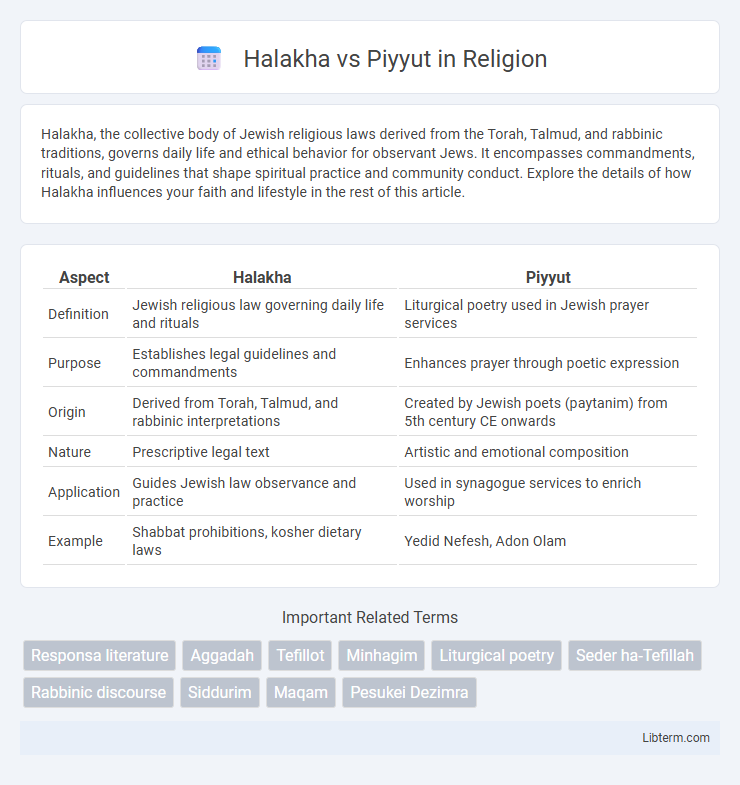Halakha, the collective body of Jewish religious laws derived from the Torah, Talmud, and rabbinic traditions, governs daily life and ethical behavior for observant Jews. It encompasses commandments, rituals, and guidelines that shape spiritual practice and community conduct. Explore the details of how Halakha influences your faith and lifestyle in the rest of this article.
Table of Comparison
| Aspect | Halakha | Piyyut |
|---|---|---|
| Definition | Jewish religious law governing daily life and rituals | Liturgical poetry used in Jewish prayer services |
| Purpose | Establishes legal guidelines and commandments | Enhances prayer through poetic expression |
| Origin | Derived from Torah, Talmud, and rabbinic interpretations | Created by Jewish poets (paytanim) from 5th century CE onwards |
| Nature | Prescriptive legal text | Artistic and emotional composition |
| Application | Guides Jewish law observance and practice | Used in synagogue services to enrich worship |
| Example | Shabbat prohibitions, kosher dietary laws | Yedid Nefesh, Adon Olam |
Introduction to Halakha and Piyyut
Halakha encompasses the collective body of Jewish religious laws derived from the Written and Oral Torah, governing daily life, rituals, and ethical conduct. Piyyut refers to liturgical poetry composed to enhance Jewish prayer services, often reflecting theological themes and historical experiences. While Halakha provides the legal framework and structure for Jewish practice, Piyyut enriches the spiritual and emotional dimensions of worship through poetic expression.
Historical Origins of Halakha
Halakha, rooted in the Torah and the Mishnah, developed through rabbinic interpretation and legal codification during the first centuries CE, establishing a comprehensive body of Jewish law. Its historical origins trace back to the efforts of the Tannaim and Amoraim, who sought to adapt biblical commandments to everyday life within the evolving Jewish communities. Unlike Piyyut--liturgical poetry flourishing in the Byzantine period as a form of religious expression--Halakha serves as a juridical framework governing religious and ethical conduct.
The Emergence and Evolution of Piyyut
Piyyut emerged in late antiquity as a distinctive form of Jewish liturgical poetry, evolving alongside Halakha's legal framework but focusing primarily on spiritual expression and communal worship rather than legal codification. Early piyyutim were composed in Hebrew and Aramaic, enriched with biblical allusions and intricate meter, reflecting cultural and religious sentiments beyond Halakha's prescriptive nature. Over centuries, piyyut evolved through various Jewish communities, incorporating regional linguistic and thematic variations while complementing the static Halakhic texts with dynamic devotional creativity.
Defining Features of Halakha
Halakha is the collective body of Jewish religious laws derived from the Written Torah and the Oral Torah, guiding religious practices and daily conduct. It consists of legal rulings, interpretations, and ethical guidelines binding the Jewish community, emphasizing obedience to commandments and jurisprudence. Unlike Piyyut, which is liturgical poetry meant to enhance prayer, Halakha serves as a practical legal framework for Jewish life and religious observance.
Literary and Artistic Dimensions of Piyyut
Piyyut, a liturgical poetry genre in Jewish tradition, exhibits rich literary and artistic dimensions characterized by intricate rhyme schemes, acrostics, and vivid biblical allusions that elevate its spiritual and aesthetic appeal. Unlike Halakha, which codifies legal and ethical norms, Piyyut serves as an expressive medium blending theological concepts with poetic creativity, often performed in synagogue services to enhance communal worship. The artistic complexity of Piyyut reflects the cultural and historical contexts of its composition, showcasing the fusion of sacred text and imaginative artistry in Jewish liturgy.
Roles in Jewish Religious Practice
Halakha serves as the comprehensive legal framework governing daily life, rituals, and ethical conduct in Judaism, ensuring adherence to divine commandments. Piyyut, on the other hand, enriches liturgical services through poetic compositions that enhance spiritual experience and communal worship. While Halakha dictates religious obligations and norms, Piyyut functions primarily to inspire emotional connection and deepen prayerful engagement in Jewish practice.
Halakha and Piyyut: Interactions and Boundaries
Halakha, the collective body of Jewish law, governs religious practices and ethical conduct, while Piyyut represents liturgical poetry integrated into synagogue worship. The interaction between Halakha and Piyyut emerges as law-prescribed rituals provide a framework for Piyyut's poetic embellishment, yet Halakha restricts Piyyut's content to maintain theological consonance and ritual propriety. Boundaries are enforced as Halakha limits alterations to prayer texts, ensuring Piyyut enhances spiritual experience without contravening established legal norms.
Authority and Flexibility: A Comparative Analysis
Halakha, the collective Jewish legal system derived from the Torah, Talmud, and rabbinical interpretations, holds authoritative power governing religious practices and daily life with strict adherence to established laws. Piyyut, a genre of liturgical poetry often incorporated into synagogue services, allows flexibility and creative expression, reflecting diverse historical and cultural influences without binding legal authority. The tension between Halakha's regulatory framework and Piyyut's artistic fluidity illustrates the dynamic interplay between normative religious law and evolving spiritual expression within Jewish tradition.
Influence on Jewish Identity and Community
Halakha, the collective body of Jewish law, profoundly shapes Jewish identity by guiding daily practices and communal norms, fostering a cohesive legal framework that unites diverse Jewish communities worldwide. Piyyut, liturgical poetry integrated into synagogue worship, enriches communal spirituality and cultural expression, reinforcing a shared historical consciousness and emotional connection to Jewish heritage. Together, Halakha's legal rigor and Piyyut's poetic tradition create a dynamic interplay that sustains both structure and soul within Jewish communal life.
Contemporary Relevance and Future Directions
Halakha and Piyyut continue to shape contemporary Jewish life through their distinct roles: Halakha governs daily religious practice and ethical conduct, while Piyyut enriches liturgical experience with poetic and musical expression. Emerging digital platforms and scholarly research are fostering renewed engagement with Piyyut, promoting its preservation and adaptation in modern worship settings. Future directions emphasize integrating Halakhic rigor with creative liturgical innovation to address evolving spiritual needs and communal identities.
Halakha Infographic

 libterm.com
libterm.com